
The Indo-Greek Kingdom, or Graeco-Indian Kingdom, also known historically as the Yavana Kingdom (Yavanarajya), was a Hellenistic-era Greek kingdom covering various parts of modern-day Afghanistan, Pakistan and northwestern India. This kingdom was in existence from c. 200 BC to c. 10 AD.

Hermaeus Soter or Hermaios Soter was a Western Indo-Greek king of the Eucratid Dynasty, who ruled the territory of Paropamisade in the Hindu-Kush region, with his capital in Alexandria of the Caucasus. Bopearachchi dates Hermaeus to c. 90–70 BCE and R. C. Senior to c. 95–80 BCE.

Kujula Kadphises was a Kushan prince who united the Yuezhi confederation in Bactria during the 1st century CE, and became the first Kushan emperor. According to the Rabatak inscription, he was the great grandfather of the great Kushan king Kanishka I. He is considered the founder of the Kushan Empire.
The Indo-Parthian Kingdom was a Parthian kingdom founded by Gondophares, and active from 19 CE to c. 226 CE. At their zenith, they ruled an area covering parts of eastern Iran, various parts of Afghanistan and the northwest regions of the Indian subcontinent. The rulers may have been members of the House of Suren, and the kingdom has even been called the "Suren Kingdom" by some authors.

Indo-Scythians were a group of nomadic Iranian peoples of Scythian origin who migrated from Central Asia southward into the northwestern Indian subcontinent, precisely into the modern-day South Asian regions of Afghanistan, Pakistan and northern India. The migrations persisted from the middle of the 2nd century BCE to the 4th century CE.

Theophilus Dicaeus was a minor Indo-Greek king who ruled for a short time in the Paropamisadae. He was possibly a relative of Zoilus I and is only known from coins. It is possible that some of Theophilus' coins in fact belong to another ruler, in Greek Bactria, during approximately the same period.
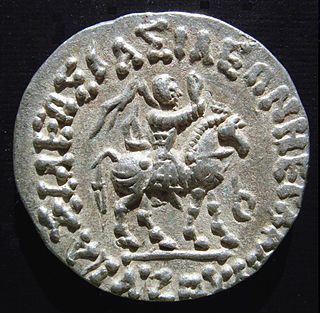
Azes II, may have been the last Indo-Scythian king, speculated to have reigned circa 35–12 BCE, in the northern Indian subcontinent. His existence has been questioned; if he did not exist, artefacts attributed to his reign, such as coins, are likely to be those of Azes I.
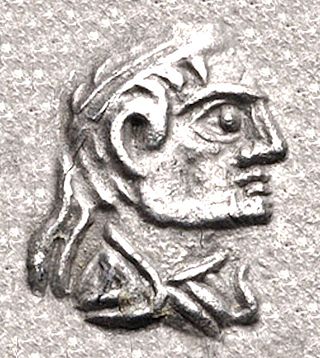
Zoilus II Soter was an Indo-Greek king who ruled in eastern Punjab. Bopearachchi dates his reign to c. 55–35 BC, a date approximately supported by R. C. Senior. It is possible that some of his coins were issued by a separate king, Zoilus III.

Apollophanes Soter was an Indo-Greek king in the area of eastern and central Punjab in modern India and Pakistan.

Diomedes Soter or Diodotus was an Indo-Greek king and possible claimant Greco-Bactrian King who may have attempted to reconquer the lands north of the Hindu Kush. The places where his coins have been found seem to indicate that his rule was based in the area of the Paropamisadae, possibly with temporary dominions further east. Judging from their similar portraits and many overlapping monograms, the young Diomedes seems to have been the heir of Philoxenus, the last king to rule before the kingdom of Menander I finally fragmented.

Zeionises was an Indo-Scythian satrap.
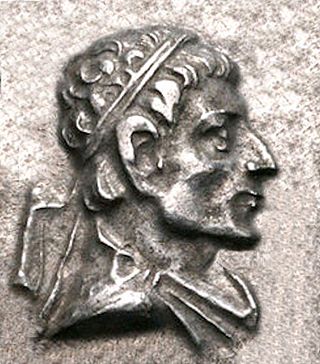
Heliocles II Dicaeus is thought to have been one of the later Indo-Greek kings and a relative of the Bactrian king Heliocles I. Current scholarly consensus is that he ruled ca 95–80 BC.
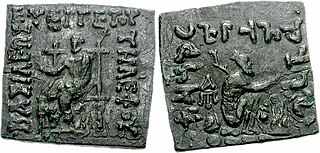
Telephus Euergetes was a late Indo-Greek king who seems to have been one of the weak and brief successors of Maues. Bopearachchi dates Telephus between 75–70 BCE and places him in Gandhara, Senior to c. 60 BCE and suggests that he ruled in some parts of Pushkalavati or even further west.
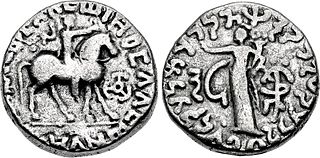
Kharahostes or Kharaosta was an Indo-Scythian ruler in the northern Indian subcontinent around 10 BCE – 10 CE. He is known from his coins, often in the name of Azes II, and possibly from an inscription on the Mathura lion capital, although another satrap Kharaostes has been discovered in Mathura.

Sodasa was an Indo-Scythian Northern Satrap and ruler of Mathura during the later part of the 1st century BCE or the early part of 1st century CE. He was the son of Rajuvula, the Great Satrap of the region from Taxila to Mathura. He is mentioned in the Mathura lion capital.
Within the Indo-Greek Kingdom there were over 30 kings, often in competition on different territories. Many of them are only known through their coins.

The History of the Indo-Greek Kingdom covers a period from the 2nd century BCE to the beginning of the 1st century CE in northern and northwestern Indian subcontinent. There were over 30 Indo-Greek kings, often in competition on different territories. Many of them are only known through their coins.

The Apracharajas, also known as Avacarajas, were an Indo-Scythian ruling dynasty of present-day western Pakistan and eastern Afghanistan. The Apracharaja capital, known as Apracapura, was located in the Bajaur district of the Khyber-Pakhtunkhwa, Pakistan. Apraca rule of Bajaur lasted from the 1st century BCE to the 1st century CE.

The Indo-Greeks practiced numerous religions during the time they ruled in the northwestern Indian subcontinent from the 2nd century BCE to the beginning of the 1st century CE. In addition to the worship of the Classical pantheon of the Greek deities found on their coins, the Indo-Greeks were involved with local faiths, particularly with Buddhism, but also with Hinduism and Zoroastrianism.

Post-Mauryan coinage refers to the period of coinage production in India, following the breakup of the Maurya Empire.

















